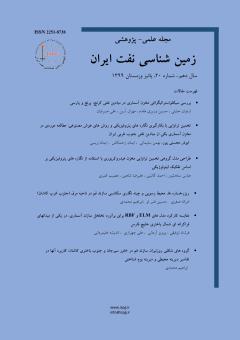طراحی مدل گروهی تخمین تراوایی مخزن هیدروکربوری با استفاده از نگاره¬هاي پتروفيزيكي بر اساس تفكيك ليتولوژيكي
محورهای موضوعی : Petrophysicsعباس سلحشور 1 * , احمد گائینی 2 , علیرضا شاهین 3 , مصیب کمری 4
1 - دانشگاه ایوانکی
2 - دانشگاه ایوانکی
3 - دانشگاه اصفهان
4 - شرکت ملی نفت
کلید واژه: تراوايي, مدل گروهي, ليتولوژي, يادگيري ماشين, نگاره هاي پتروفيزيكي.,
چکیده مقاله :
تراوايي يا نفوذپذيري، یکی از خصوصیات مهم مخازن نفت و گاز است که پیش بینی آن دشوارمي باشد. در حل حاضر از مدل های تجربی و رگرسیوني برای پیش بینی نفوذپذیری استفاده مي شود كه شامل صرف زمان و هزينه هاي زياد مرتبط با اندازه گیری آزمایشگاهی است. در چند وقت اخیر، به دلیل قابلیت پیش بینی بهتر، از الگوریتم های یادگیری ماشین برای پیش بینی تراوايي استفاده شده است. در این مطالعه، مدل یادگیری ماشین گروهي جدیدي برای پیش بینی تراوايي در مخازن نفت و گاز معرفی شده است. در این روش ، داده های ورودي با استفاده از اطلاعات ليتولوژي لاگ ها برچسب گذاري شده و به تعدادي از دسته ها تفكيك مي شوند و هر دسته توسط الگوریتم یادگیری ماشین مدل سازی شد. برخلاف مطالعات قبلی که به صورت مستقل روي مدل ها كار مي كردند در اينجا ما ضمن طراحي يك مدل گروهي با استفاده از الگوريتم هاي ETR وDTR و GBR و داده هاي پتروفيزيكي، توانستيم صحت و دقت پيش بيني همچينين خطاي ميانگين مربعات را به طرز چشم گيري بهبود ببخشيم و تراوايي را با دقت 99.82 درصد پيش بيني كنيم. نتایج نشان داد که مدل های گروهي در بهبود دقت پیش بینی تراوايي در مقایسه با مدل های انفرادي تاثير فراواني دارند و همچنين تفكيك نمونه ها بر اساس اطلاعات ليتوژي دليلي بر بهينه نمودن تخمين تروايي نسبت به تحقيقات گذشته بود.
Permeability is one of the important characteristics of oil and gas reservoirs that is difficult to predict. In the present solution, experimental and regression models are used to predict permeability, which includes time and high costs associated with laboratory measurements. Recently, machine learning algorithms have been used to predict permeability due to better predictability. In this study, a new ensemble machine learning model for permeability prediction in oil and gas reservoirs is introduced. In this method, the input data are labeled using the lithology information of the logs and divided into a number of categories and each category was modeled by machine learning algorithm. Unlike previous studies that worked independently on models, here we were able to predict the accuracy of such a square mean error by designing a group model using ETR, DTR, GBR algorithms and petrophysical data. Improve dramatically and predict permeability with 99.82% accuracy. The results showed that group models have a great effect on improving the accuracy of permeability prediction compared to individual models and also the separation of samples based on lithology information was a reason to optimize the Trojan estimate compared to previous studies.

